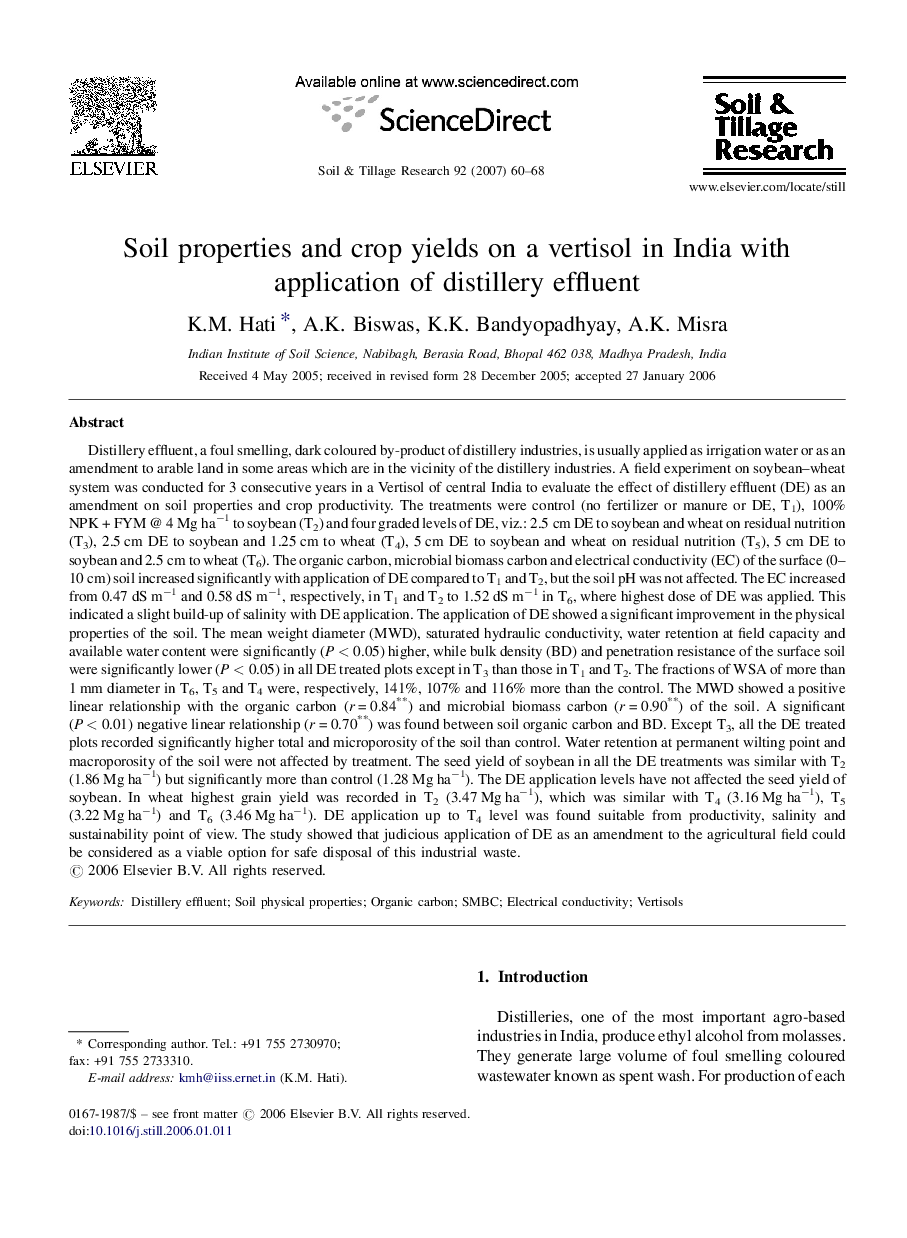| کد مقاله | کد نشریه | سال انتشار | مقاله انگلیسی | نسخه تمام متن |
|---|---|---|---|---|
| 306776 | 513114 | 2007 | 9 صفحه PDF | دانلود رایگان |

Distillery effluent, a foul smelling, dark coloured by-product of distillery industries, is usually applied as irrigation water or as an amendment to arable land in some areas which are in the vicinity of the distillery industries. A field experiment on soybean–wheat system was conducted for 3 consecutive years in a Vertisol of central India to evaluate the effect of distillery effluent (DE) as an amendment on soil properties and crop productivity. The treatments were control (no fertilizer or manure or DE, T1), 100% NPK + FYM @ 4 Mg ha−1 to soybean (T2) and four graded levels of DE, viz.: 2.5 cm DE to soybean and wheat on residual nutrition (T3), 2.5 cm DE to soybean and 1.25 cm to wheat (T4), 5 cm DE to soybean and wheat on residual nutrition (T5), 5 cm DE to soybean and 2.5 cm to wheat (T6). The organic carbon, microbial biomass carbon and electrical conductivity (EC) of the surface (0–10 cm) soil increased significantly with application of DE compared to T1 and T2, but the soil pH was not affected. The EC increased from 0.47 dS m−1 and 0.58 dS m−1, respectively, in T1 and T2 to 1.52 dS m−1 in T6, where highest dose of DE was applied. This indicated a slight build-up of salinity with DE application. The application of DE showed a significant improvement in the physical properties of the soil. The mean weight diameter (MWD), saturated hydraulic conductivity, water retention at field capacity and available water content were significantly (P < 0.05) higher, while bulk density (BD) and penetration resistance of the surface soil were significantly lower (P < 0.05) in all DE treated plots except in T3 than those in T1 and T2. The fractions of WSA of more than 1 mm diameter in T6, T5 and T4 were, respectively, 141%, 107% and 116% more than the control. The MWD showed a positive linear relationship with the organic carbon (r = 0.84**) and microbial biomass carbon (r = 0.90**) of the soil. A significant (P < 0.01) negative linear relationship (r = 0.70**) was found between soil organic carbon and BD. Except T3, all the DE treated plots recorded significantly higher total and microporosity of the soil than control. Water retention at permanent wilting point and macroporosity of the soil were not affected by treatment. The seed yield of soybean in all the DE treatments was similar with T2 (1.86 Mg ha−1) but significantly more than control (1.28 Mg ha−1). The DE application levels have not affected the seed yield of soybean. In wheat highest grain yield was recorded in T2 (3.47 Mg ha−1), which was similar with T4 (3.16 Mg ha−1), T5 (3.22 Mg ha−1) and T6 (3.46 Mg ha−1). DE application up to T4 level was found suitable from productivity, salinity and sustainability point of view. The study showed that judicious application of DE as an amendment to the agricultural field could be considered as a viable option for safe disposal of this industrial waste.
Journal: Soil and Tillage Research - Volume 92, Issues 1–2, January 2007, Pages 60–68